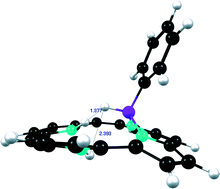The structures of a number of mono- and diboron corrole complexes have been optimized using DFT methods in order to establish regio- and stereochemical preferences for bonding of one or two boron atoms to the corrole macrocycle. The formulations of the complexes were suggested either from preliminary experimental results (to be reported elsewhere) or by analogy with related diboron porphyrin compounds. The computational results suggest for the monoboron corroles BF2(H2corrole) and BPhH(H2corrole) that the regioisomer in which the boron is bound to a dipyrromethene site adjacent to the bipyrrole is preferred over the other possible regioisomers in which boron coordinates either in the bipyrrole or in the dipyrromethene site opposite the bipyrrole. In the N-substituted corrole complexes there are only two possiblities and, for each complex, the regioisomer with boron in the dipyrromethene site adjacent to the bipyrrole is lower in energy. For all four monoboron complexes the stereoisomers in which boron and both its substituents are displaced out of the mean N4 plane are more stable than the boron in-plane stereoisomers. These regio- and stereochemical preferences are rationalised by an analysis of the deformations to the corrole macrocycle and the geometry at the boron atoms. The lowest energy structures in all cases correspond to the least strained configurations. In addition, all four complexes show significant BF⋯HN hydrogen bonding and BH⋯HN dihydrogen bonding interactions, which are maximised in the lowest energy configurations for each structure, indicating that these are important additional stabilising interactions. Three different regioisomers, each with cisoid or transoid stereochemistry were optimised for the diboron complex PhBOB(corrole) which contains a bridging BOB group. The dipyrromethene/dipyrromethene isomer is more stable than either of the dipyrromethene/bipyrrole isomers and cisoid stereochemistry is preferred over transoid. This contrasts with porphyrin complexes containing BOB groups for which both stereochemical possibilities are observed, and reflects the contracted size of the corrole macrocycle. Three further diboron corroles were investigated, the diboranyl cation [B2(corrole)]+ and its one- and two-electron reduced derivatives B2(corrole) and [B2(corrole)]−. These calculations were undertaken to determine whether the site of reduction of [B2(corrole)]+ is likely to be the diboron moiety or the macrocycle. The B–B bond lengths do not shorten upon reduction and an analysis of the molecular orbitals of each species indicates that reduction will be most likely to occur at the macrocycle, offering a potential route to an example of the two-electron reduced corrole ligand, an analogue of the 20-electron isophlorin ligand observed in the corresponding reduced porphyrin complex B2(porphine).

You have access to this article
 Please wait while we load your content...
Something went wrong. Try again?
Please wait while we load your content...
Something went wrong. Try again?


 Please wait while we load your content...
Please wait while we load your content...